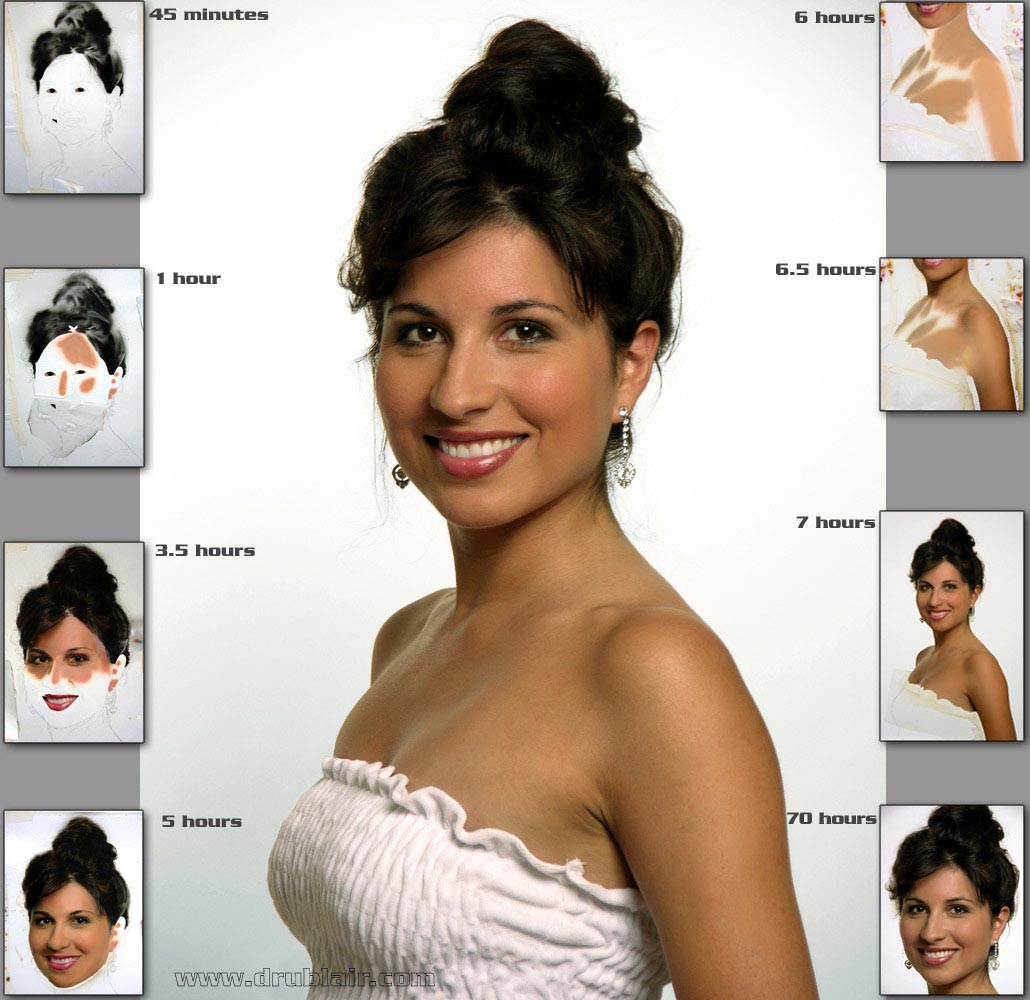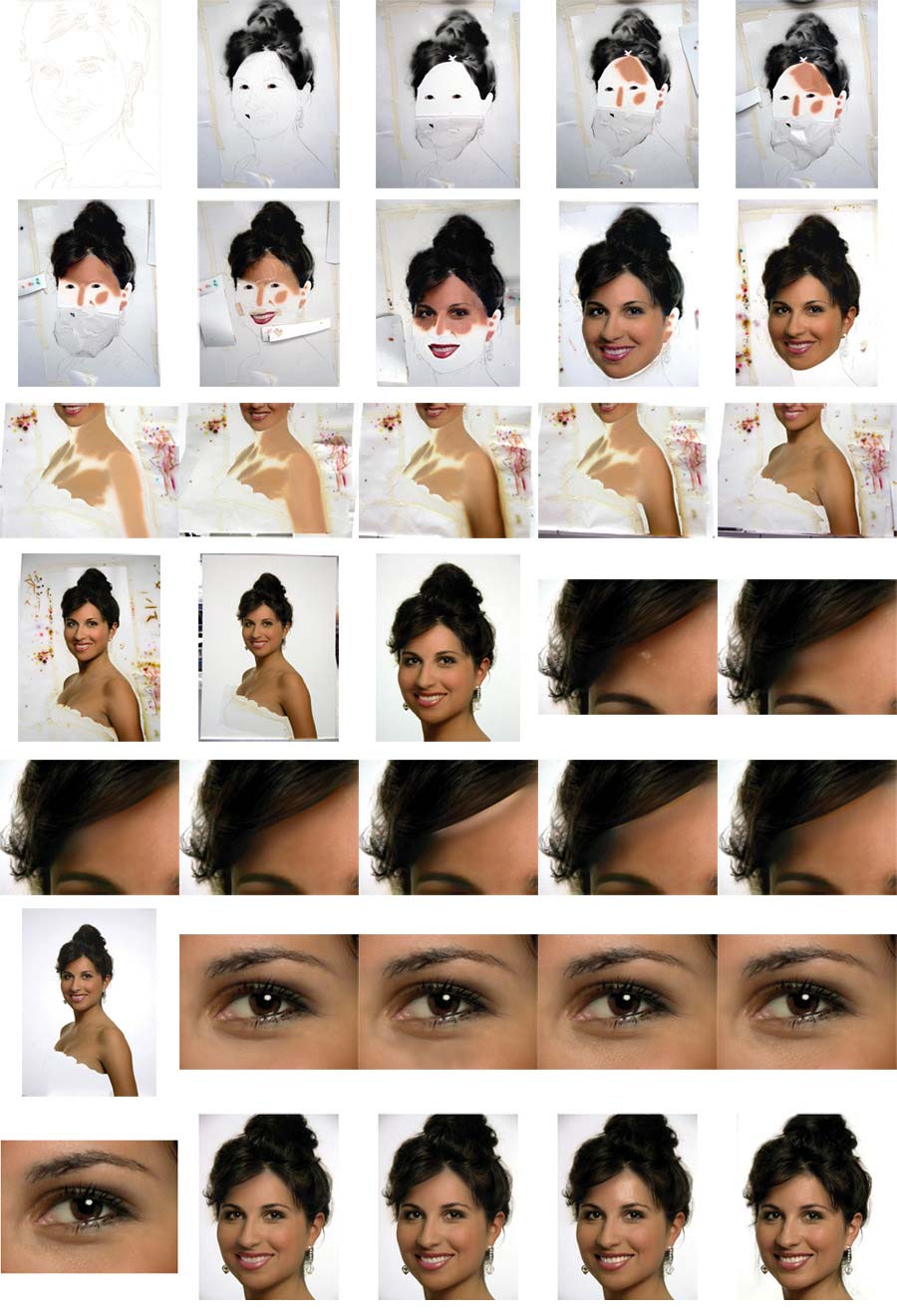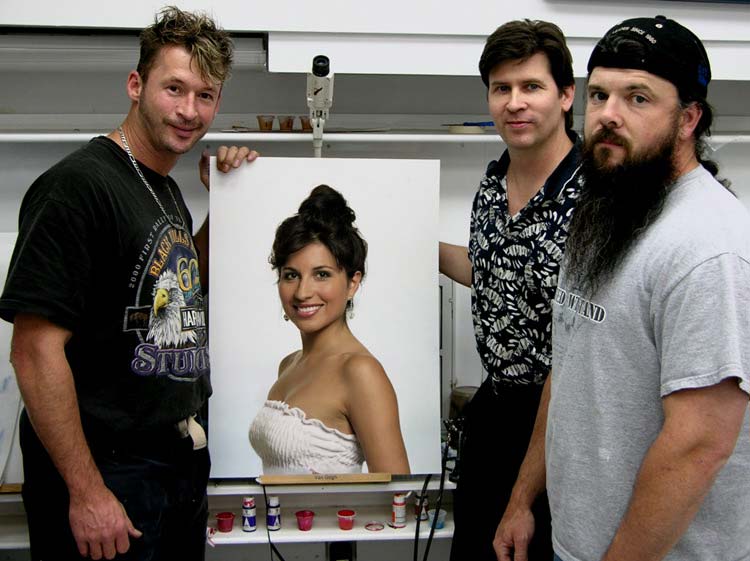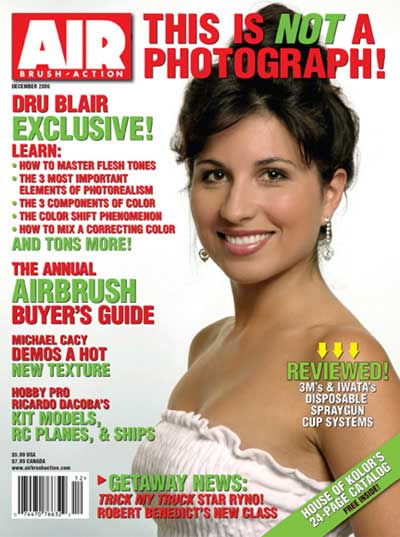Painting of Tica by Dru Blair - a 70 hours work

This is a painting completed in February 2005. It was a Portrait Class project that I decided to finish in my spare time after the workshop. It probably took a total of around 65-75 hours to complete. The small images are step by step photographs taken during the painting process, and the large image is the final painting after detail and skin texture are added with an eraser and colored pencil. The main colors are blocked in at the beginning, but refinement is withheld until the very end. Look for a more complete step by step article in an upcoming magazine issue~Dru Blair

After a couple of hours of color adjustment, I've reached the 10 hour mark. At this stage, detail has not been added to the face, because it is best to wait until all the colors are correct first.
There are many areas still to be corrected. For example, one of the front teeth is too dark. The arm is also too dark at the edges.
I usually wait until the very end to introduce skin and hair texture.
10 hours


 |
| Ian, Dru and Darryl pose in front of the Tica original painting during the April 05 Workshop. The original and several other paintings are on display in the school. |
|
This painting started as an exercise for a portrait workshop I taught in 2005. My previous exercise in portraiture was the Vanessa painting. In order to provide the best reference for my students, I took a digital photograph in my studio of a local model (Tica) with my Nikon Coolpix 8700, then printed copies for each student on my Epson 9600 printer. The goal was to work from reference that provided great lighting, good detail, and accurate skin tones. I intentionally lit and posed Tica in the manner of the old masters, but used contemporary portrait studio elements (such as the smile and white background), to expose the most subtle nuances of her face. Tica has incredible skin, with a challenging range of colors. As it turned out, the range of colors in her skin proved to be a little overwhelming. Normally, it takes me about 7 or 8 colors to recreate an individual's skin palette, and I blend those on the board to create many more. However with Tica, I found it necessary to mix around 20 different colors to capture her range of color. There were also a few interesting artifacts introduced by the digital camera such as a blue halo around the earring, but I decided to include them in the final painting, because they seemed visually interesting. By the time the class ended on Sunday, most students had reached a level of completion equivalent to the third image down on the left of the step by step sequence ( I intentionally omitted many of the step by step photographs because I don't want to spoil the upcoming magazine article on the creation of this painting). I need to add here that the purpose of my workshops is not to complete a painting, but rather to use the time optimally so that each student learns the techniques and visual skills necessary to create a photorealistic painting. Once I'm convinced that each student has a grasp of a specific feature, we then move on to another area of the face.
Photorealism: As a style, Photorealism has a few detractors, who often dismiss it as pointless, or non-art. They fail to realize that many photorealistic paintings are not mere copies of photographs, but interpretations of reality based on the artist's vision. The act of merely copying a photograph has no artistic merit except to hone one's artistic skills. Most of my aviation paintings would be impossible to photograph, such as Timing is Everything for example. This painting of Tica is not just a copy of a photograph, but is a product of many artistic decisions, whereas I deviated from the reference photo for more aesthetic appeal. Often, the artist's deviation from the reference material is unconscious. Despite my best efforts, my own unconscious stylization creeps into all of my work, and it is a struggle to keep it subdued. Photographic reference is almost always used as a guide by photorealists, but becomes less necessary as an artist gains proficiency, and understanding of the elements of photorealism. While reading the list of the elements of realism, consider that no other artistic style demands so much of an artist. Photorealism is by far, the most difficult artistic style to master. Elements of photorealism: If any of these elements are amiss, the painting will fail as a photorealistic image. In truth, these elements are simply descriptions of the visual experience of reality. If an artist ever wanted to put his or her artistic skills to the test, there is no greater master than reality. Art: (my definition) Art is the selective re-creation or conversion of reality by the human mind into concrete imagery according to an artist's metaphysical value judgments. Real or imagined concepts are filtered and altered through the human mind to the artist's hand to create an image or sound that did not exist before. The reason photography does not qualify |




 After the class concluded, I remained in the studio contemplating Tica's image. After some deliberation, I decided to test the limits of my visual skills by completing the project painting. The realism of almost all of my previous paintings was compromised by time constraints and deadlines, but I imposed no deadline on myself this time. Nearing completion of the painting, I decided to remove some of the elements I had already painted such as the nap of cloth next to her armpit (see image). This unfinished painting is not without flaws, which are mercifully reduced by the computer screen's 72 dpi resolution. I could have invested another 50 hours in it, but the improvements would have been subtle. Besides, by then, I was ready to move on to another project.
After the class concluded, I remained in the studio contemplating Tica's image. After some deliberation, I decided to test the limits of my visual skills by completing the project painting. The realism of almost all of my previous paintings was compromised by time constraints and deadlines, but I imposed no deadline on myself this time. Nearing completion of the painting, I decided to remove some of the elements I had already painted such as the nap of cloth next to her armpit (see image). This unfinished painting is not without flaws, which are mercifully reduced by the computer screen's 72 dpi resolution. I could have invested another 50 hours in it, but the improvements would have been subtle. Besides, by then, I was ready to move on to another project.
